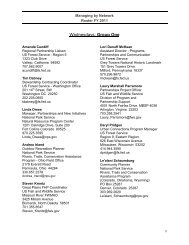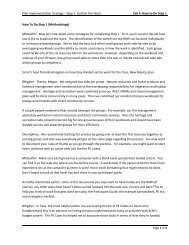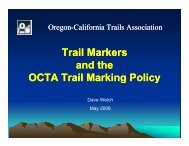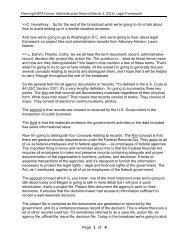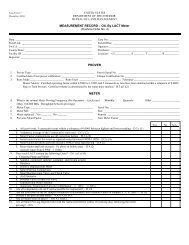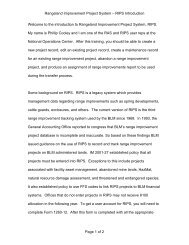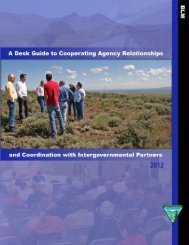1. History of O&C Lands
1. History of O&C Lands
1. History of O&C Lands
- No tags were found...
Create successful ePaper yourself
Turn your PDF publications into a flip-book with our unique Google optimized e-Paper software.
Polk’s War with Mexico• Not only acquired Texas, but California aswell• After Polk’s term ended in 1849, a rich golddeposit was discovered, and the rush was on• Growing populations on the Pacific coastcreated need for faster transportationconnection
• During the 1850’s, a national debate took place onwhere to build a transcontinental railroad• Four possible routes• Deadlock in Congress over the route because <strong>of</strong>north-south contentiono• Civil War broke the deadlock
Transportation to West coast in 1850’sClipper ships around theHornOrHorse, mule, or oxendriven wagon over theOregon Trail
President Abraham LincolnProminent railroad attorney at thetime he was running forPresidentHis platform included thefollowing:“That a railroad to the PacificOcean is imperativelydemanded by the interests <strong>of</strong> thewhole country; that the FederalGovernment ought to renderimmediate and efficient aid inits construction.”
President Abraham LincolnOne <strong>of</strong> the interests served byOne <strong>of</strong> the interests served bythe railroad connection tothe west was to keepCalifornia, Oregon andterritories in the Union
Building a Railway systemPresident Abraham Lincolnsigned the Pacific RailwayAct in part <strong>of</strong> the darkestperiods <strong>of</strong> the Civil War onJuly 1, 1862.This act provided Federalgovernment support for thebuilding <strong>of</strong> the firsttranscontinental railroad,which was completed onMay 10, 1869.
Land grants subsidize the building <strong>of</strong>railroads and wagon roadsFighting a Civil War, Congress had little money tospare, but did have a lot <strong>of</strong> public lands1850-1870 Congress passed twenty-four separate actsgranting companies130 million acres <strong>of</strong> public domain in the trans-Mississippi westAn area the size <strong>of</strong> Texas
Transcontinental Railroad• Central Pacific Railroad• Union Pacific Railroad• 1863-1869• Alternative sections <strong>of</strong> public land granted to railroads tosubsidize construction and create customers• New towns, such as Laramie and Cheyenne created
Trip to San Francisco from the east• Before railroad: Over $1000 and months• After railroad: $70-$150 and seven days
1862 Homestead ActAlso in 1862 Congresspassed the HomesteadAct which increasedsettlement in the West,by giving 160 acres <strong>of</strong>free land dto any personwho had lived on theland and improved it forfive years.
General Land OfficeThe Homestead Act andthe railroad grantsgreatly increasedresponsibilities for theGeneral Land Office
Birth <strong>of</strong> the O&CLeland Stanford, the Central Pacific Railroad sets up theCalifornia and Oregon Railroad in 1865 to build a routefrom Sacramento to the Oregon borderCongress establishes land grant in July 1866 to completeOregon tie from California border to Portland
1866 O&C Railroad Grant
1866 O&C Railroad Grant
Terms <strong>of</strong> 1866 Act3.7 million acres12,800 acres/mile <strong>of</strong> trackPrimary ygrant – 20 miles either side <strong>of</strong> routeIndemnity lands – additional 10 miles(30 miles total)
Recipient railroad designated by OregonlegislatureOregon Central railroad located in Salem,intended d to build west side <strong>of</strong> WillametteOregon Central railroad located in Portland,intended to build east side <strong>of</strong> Willamette
No immediate public demand d for the grant lands, bothcompanies had financial problemsCalled on Congress for further assistanceCongressional committees more concerned withprotecting national interestWartime fervor for internal improvements cooled
Supplementary Act 1870• Any railroad• <strong>Lands</strong> to be sold only to “actual settlers”• No more than ¼ section, 160 acres• No more than $2.50 acre
Before President Ulysses Grant signed the bill,
Ben Holladay secured control <strong>of</strong> both OregonCentral railroads and renamed it theOregon and California Railroad
How the O&C Plan WorkedUnited States transferred O&C lands to the State<strong>of</strong> OregonState <strong>of</strong> Oregon transferred O&C lands to therailroadRailroad transferred O&C lands to settlers andpurchasers
Railroad was not liable for taxes until taking titleto landsRailroad delayed taking title, kept lands withState <strong>of</strong> fOregon
O&C Railroad Co. builtsouth along the east side<strong>of</strong> the WillametteBridged the Clackamas,Molalla, Santiam RiversOver the UmpquaCl Calapooia divide diid
1872 the O&C Railroadreached RoseburgTowns that were born <strong>of</strong> therailroad:Canby, Tangent, OaklandHarrisburg, Creswell,Drain, Yoncalla,(knocked out the WillametteSteamboat service)
Trouble• Free homesteads• Heavy timber• Steep topography
Villard’s Take Over• 1873 Henry Villardrepresenting Germanstockholders took overthe company• Reorganized, strategy todispose <strong>of</strong> lands to raisecapital
Because <strong>of</strong> financialtrouble, constructionstalled and for nineyears the O&CRailroad terminated inRoseburgRoseburg prosperity asKlamath Falls andRogue Valley shippedin and out <strong>of</strong> Roseburg
1881 Construction resumedalong the South UmpquaRiver, Cow Creek canyon,over the Umpqua Mountainsto the Rogue ValleyTowns that were born <strong>of</strong> therailroad: Riddle, Glendale,Grants Pass, Medfordd(Jacksonville became almosta ghost town after bypassedby the railroad)
Bankruptcy – Villard loses controlThe O&C acquired (leased) by theSouthern Pacific (1887-1927)
Golden Spike at AshlandDecember 17, 1887This event was important to the entire nation,as it completed the railroad circle around theUnited States
Turn <strong>of</strong> CenturyConservationPopulismProgressivismPopulists called for federalownership <strong>of</strong> allrailroads and recovery<strong>of</strong> land grants
Edward HarrimanTook over the Union Pacificand other linesControlled the SouthernPacific, hence the O&CRailroadMade many <strong>of</strong> the decisionsthat led to battle with theState <strong>of</strong> Oregon and Federalgovernment over the O&CRailroad
1890’s, Southern Pacific sold hundreds <strong>of</strong>thousands <strong>of</strong> acres at prices up to $40 acreOne sale to a single purchaser was 45,000 acresat $7 an acreSpeculators employed dummy entrymen to frontas “actual al settlers”
President Grover ClevelandJust before leaving <strong>of</strong>ficein 1897, createdNational Forests byEectieOrderExecutive
President Teddy RooseveltExecutive Order expandedNational Forests,created NationalMonuments andWildlife RefugesShifted forest policy fromInterior to Agricultureunder Gifford Pinchot
1902 Southern Pacific under Edward Harriman sold400,000 acres to speculators and lumbermen.Anticipating rising values, Harriman halted all salesAll three stipulations <strong>of</strong> O&C Act had been violatedOregonians finally reacted at the announcement thathalt <strong>of</strong> land sales was permanent
Increased evidence <strong>of</strong>fraud, malfeasanceOregonian articles1902 Roosevelt appointedSpecial Prosecutor toinvestigate
1904-1908Oregon land fraud trialsCongressmen, <strong>of</strong>ficials <strong>of</strong> General Land Office wereindicted, convictions1904 Oregonian discovered and reported the “actualsettlers” clause1907 Oregon legislature petitioned Congress to compelrailroad to meet terms <strong>of</strong> O&C ActGovernor Chamberlain confronts Harriman at a fair
1908 Looters <strong>of</strong> the Public Domain published1908 Justice Department brings suit againstSouthern Oregon Company (successor to CoosBay Wagon Road Company)
1908 Senate resolution directed the attorneygeneral to bring lawsuitFederal court deliberated for five yearsJudge Wolverton <strong>of</strong> federal district court inPortland ruled (July 1913)Judgment puzzled everyone and satisfied no one(lands not sold forfeit)Appealed to the Supreme Court
June 1915 Supreme Court RulingUnsold grant land (both patented and unpatented)2.3 million acres50 billion board feetCould be disposed <strong>of</strong> by Congress within reasonable timeIf Congress did not act in six months, district court could dispose <strong>of</strong>unsold lands and timber
1916 Chamberlain-Ferris ActSigned by WoodrowWilson, revest 2.8million acres
Sell land and timber as fast as possible<strong>1.</strong> Pay the railroad2. Pay treasury for taxes during litigation3. 25% state, 25% counties, 10% U.S.40% Reclamation FundSouthern Pacific brought suit as to constitutionality. Supreme Courtruled for the governmentSouthern Pacific sued for financial i loss and won $4 million
1919 Coos Bay Wagon RoadRevestmentSigned by WoodrowWilson,Revested 93,063 acres
Timber sales– Public Auction –terms: cashGLO employees would ask timber companieswhat they were willing to pay1916-1937 One instance <strong>of</strong> competitive bid atpRoseburg Office. (resulted in brawl, reducedGLO <strong>of</strong>fice to shambles)
President Calvin Coolidge1926-1927 “CoolidgeProsperity”, nationwideboomLogging and timber receiptsbest yet, but still lowactivity i compared toprivateAssociation <strong>of</strong> O&C Countiespressed for a fix
1926 Stanfield ActSigned by Calvin Coolidge July 1926 after the presidentnegotiated certain termsRelieve economic distress <strong>of</strong> counties because <strong>of</strong> lack <strong>of</strong> revenuefrom the O&C landsGrant $7 million to counties1928 Supreme Court rejected Oregon’s suit to share in Stanfieldpayments1916 formula for payments remained in place
Association <strong>of</strong> O&C CountiesEstablished in 1926Promoted passage <strong>of</strong> Stanfield billAOCC 78 year history <strong>of</strong> workingwith the federal government onthe management <strong>of</strong> the O&Clands.Guy Cordon <strong>of</strong> Douglas Countyy g yfounded AOCC
President Herbert HooverProsperity prompts Hoover’sdesire to withdraw federalgovernment from forestryenterpriseSecretary <strong>of</strong> Interior Wilburfavors:• Move O&C to Agriculture,• Consolidate all forestryunder one agency,• States to take overadministration <strong>of</strong> surfacerights to public domain
Sustained YieldDavid Mason, consulting foresterfrom Portland campaigned forsustained yield forestry as earlyas 1926Best interests <strong>of</strong> forestry andlumberingSystem <strong>of</strong> controlling rate <strong>of</strong> cut inorder to perpetuate supplyEnvisioned cooperation amonglumbermen as well as federaland statet
1916 -1937O&C InterestsCourtsRailroadCountiesTimberland Congress General PublicOwnersConservationistsNon-landowningTimber businessAlternativeFederal ExecutiveBranchLand Managers
President Franklin RooseveltAdministration addressedthe Depression andWorld War IINew Deal, WPA, TVA,NRA, CCC, REAdesigned to reviveAmerica
Harold Ickes, Secretary <strong>of</strong>Interior 1933 to 1945,saw the O&C as anopportunity for Interiorto showcase modern,efficient i and scientificforestry
Secretary <strong>of</strong> AgricultureSecretary <strong>of</strong> AgricultureHenry Wallace 1933 to1940 wanted to movethe O&C to the ForestService
Rufus Poole, Interior attorney andDavid Mason drafted HR 5858 in1936House and Senate committee hearingsregarding sustained yield forestrySecretary Wallace attempted tosubstitute “Agriculture” at everypoint bill gave authority to InteriorRe-election <strong>of</strong> Franklin Roosevelt
The O&C Act, August 28, 1937Title teISustained yield, permanent forest production andtimber supply, determine and declare annualproductive capacity, grazing, recreational facilities,protect watersheds, regulate stream flows, powersitesTitle IIAdministrative costs, payments, distribution <strong>of</strong>receipts
Walter HorningChief forester and first director<strong>of</strong> the O&CPr<strong>of</strong>essor <strong>of</strong> forestry fromIowa State, helpedformulate forest policy forthe National Park Service,analyzed dSecretary Ickes’Olympic National ParkproposalStarted with a budget <strong>of</strong>$150,000
Recruited small staffDecision not to createprocedural lhandbooksimilar to the ForestServiceOpened district <strong>of</strong>fices inMedford, Roseburg,Eugene in 1938, Salem1943, Marshfield (CoosBay) 1944
Allocation <strong>of</strong> Revenues50% payable to 18 O&C counties25% proceeds reimburse US treasury forpayments made to counties for lost tax revenueand repayment <strong>of</strong> fSouthern Pacific25% proceeds to administer O&C Act
After treasury was reimbursed the 25% was to beapplied to 18 O&C Counties75% Counties25% US Treasury
1953 Plowback FundCounties dedicated 25% to federal government asCounties dedicated 25% to federal government asan investment in the management <strong>of</strong> O&C lands
Plowback to the BLM allowed funding <strong>of</strong>:• Reforestation and elimination <strong>of</strong> backlog acres• Funding <strong>of</strong> nurseries for seed, seedlings• Seed orchards• Intensive practices <strong>of</strong> thinning, fertilization, treeimprovement• Intensive inventory
Allowable Cut EffectIntensive practices allow more timber to begrown (productive capacity) per year thereforemore timber can be harvested per year on asustained yield basis.Standing harvestable volume allows animmediate short term return on investment inintensive practices. (ACE)
Success at Sustained Yield ForestryDecadal inventories in 1970, 1980 and 1990showed that there was more standing volumeon the O&C <strong>Lands</strong> than the previous decade.Af 50 f h di lAfter 50 years <strong>of</strong> harvest, standing volume onthe O&C <strong>Lands</strong> has increased.
Plowback funded:• access roads• bid bridges• district <strong>of</strong>fices• fire protection• recreation sites1982 W t O BLM i d di t i ti1982 Western Oregon BLM received direct appropriationsfrom Congress, no longer funded through Plowback
Reciprocal Rights <strong>of</strong> WayLeonard Netzorg, anattorney for BLM,wrote the rights <strong>of</strong> wayregulations and forms <strong>of</strong>agreements thatstipulated reciprocalaccess to federal andprivate timberland, thusbreaking Big Lumber’schokehold on the familyowned mills
President Richard Nixon1969 National EnvironmentalPolicy Act1969 Council onEnvironmental Qualityestablished1970Clean Air Act ct(extension)1972 Federal Water PollutionControl Act1973 Endangered Species Act
President Jimmy CarterOctober 1976 FederalLand ManagementPolicy Act1977 Planning underwayin western Oregon
President Ronald Reagan1979-1983 WesternOregon plans completed1982 - BLM’s Policy1982 BLM s PolicyStatement on ManagingO&C lands
BLM Policy Statement forManagement <strong>of</strong> O&C <strong>Lands</strong>May 1982 Director <strong>of</strong> the BLM Burford requests through theSecretary <strong>of</strong> Interior an opinion from Office <strong>of</strong> Solicitorregarding legal adequacy <strong>of</strong> policy statement regardingmultiple use management on O&C landsLand Use Planning for 13 Sustained Yield Units and EIS’s werein progressNeeded to respond to public comments questioning interpretation<strong>of</strong> O&C Act in light <strong>of</strong> Clean Water Act, Endangered SpeciesAct, Clean Air Act and National Environmental Policy Act
O&C Policy Statement encompassed six objectives:Timber production, water quality, wetlands, T&Especies, habitat diversity, i recreation“Primary objectives <strong>of</strong> the management program on theO&C lands are to manage for a high-level and sustainedyield output <strong>of</strong> wood products needed to contribute toeconomic stability <strong>of</strong> local communities and industries,and to provide for other land uses as established in theO&C Act and other legislation. ”
Solicitor reviewed language <strong>of</strong> O&C Act, its legislativehistory and subsequent legislationSeptember 1982 Solicitor’s Office 10 page opinion <strong>of</strong>legal adequacy <strong>of</strong> BLM policy statement for multipleuse management <strong>of</strong> O&C <strong>Lands</strong>Forest production in dominant roleDoes not mandate exclusive use
Bureau must meld dominant use <strong>of</strong> forest productionwith those aspects <strong>of</strong> multiple use envisioned by theO&C Act in addition to requirements <strong>of</strong> subsequentlegislationO&C Act limits Bureau’s management options on O&Clands but provides to a certain degree significantifi discretion how competing objectives are metBLM policy on management <strong>of</strong> O&C Act struckappropriate balance
Late 1980’s-early 1990’sLitigation regarding spotted owl managementdropped harvest levels significantly
Portland Audubon Society v BLM• On May 18, 1988, the Ninth Circuit Court <strong>of</strong> Appealsstopped the BLM’s entire timber sales program, notjust the timber sales in spotted owl habitat. The“temporary” injunction nction was later reduced, but kept inplace for the remainder <strong>of</strong> the year while the Circuitconsidered its opinion. Except for FY 1990, when alegislative rider (Sec. 318) exempted BLM timbersales from the injunction and with a few otherexceptions, the BLM's timber sales were curtailedfrom 1988 until January 5, 1995 — a little over 7years after the case was brought.
Headwaters v. BLMNinth Circuit ruling on O&CWilcox Peak – 1990Plaintiff argued BLM misinterpreted O&C ActPlaintiff argued O&C Act requires BLM tomanage these lands for multiple use includingwildlife conservation rather than for dominantuse <strong>of</strong> timber production
“We have previously observed that “theprovisions <strong>of</strong> 43 U.S.C. 1181a make it clearthat the primary use <strong>of</strong> the [O&C Act] lands isfor timber production to be managed inconformity with sustained yield. ”(9 th Cir. 1990)
Plaintiff argued that the phrase “forestproduction” in section 1181a encompasses notmerely timber production, but alsoconservation values such as preserving habitatfor the northern spotted owl.
9 th Circuit:“inconsistent with the principle <strong>of</strong> sustained yield”“statute clearly envisions sustained yield harvesting<strong>of</strong> O&C lands”“There is no indication that Congress intended“forest” to mean anything beyond an aggregation <strong>of</strong>timber resources.”
Declarations <strong>of</strong> Sustained Yield Capacity14001200112711601000874MMBF80060050053566069276940020020301937 1954 1956 1957 1958 1959 1962 1985 1995Year
1986 -2007O&C InterestsCourtsRailroadCountiesTimberland Congress General PublicOwnersConservationistsNon-landowningTimber businessAlternativeFederal ExecutiveBranchLand Managers
1986 -2007O&C InterestsCourtsCountiesTimberland Congress General PublicOwnersConservationistsNon-landowningTimber businessAlternativeFederal ExecutiveBranchLand Managers
1986 -2007O&C InterestsCourtsFish InterestsCountiesTimberland Congress General PublicOwnersConservationistsNon-landowningTimber businessAlternativeFederal ExecutiveBranchLand Managers
1986 -2007O&C InterestsCourtsFish InterestsCountiesTimberland Congress General PublicOwnersConservationistsNon-landowningTimber businessAlternativeFederal ExecutiveBranchLand Managers
1986 -2007O&C InterestsCourtsFish InterestsCountiesTimberland Congress General PublicOwnersNon-landowningTimber businessAlternativeLand ManagersFederal ExecutiveBranch
1986 -2007O&C InterestsCourtsFish InterestsCountiesTimberland Congress General PublicOwnersEnvironmentalistsNon-landowningTimber businessAlternativeFederal ExecutiveBranchLand Managers
1986 -2007O&C InterestsCourtsFish InterestsCountiesTimberland Congress General PublicOwnersEnvironmentalistsNon-landowningTimber businessAlternativeFederal ExecutiveBranchLand Managers
1989 Hatfield-Adams Amendment (NorthwestCompromise)Environmental groups obtained injunction prohibiting sale<strong>of</strong> old growth timber on BLM lands near spotted owlsitesRider to 1990 Interior appropriations bill(Section 318)Sufficiency language for timber sales
To stabilize O&C county revenues, appropriationlanguage for 1991, 1992 and 1993 included aprovision for floor payment <strong>of</strong> 1986 to 1990 annualaverageOmnibus Budget Reconciliation Act <strong>of</strong> 1993(Safety Net)O&C counties with “Special Payment Amount” basedon annually decreasing percentage <strong>of</strong> the five yearaverage (1986-1990)1990)1994-2003 $79 million decreasing to $54 million
President Bill Clinton• April 2003 holds ForestConference in Portlandto bring all interests to acommon purpose• Appoints Jack WardThomas to head acommittee <strong>of</strong> scientiststo come up with a planto get out <strong>of</strong> the legalgridlock
Northwest Forest Plan• A year later BLM and Forest Service beginmanaging under a common plan, that reducedtimber harvest to only 20% <strong>of</strong> historic levels,set aside in reserves about 85% <strong>of</strong> federalforest lands, and applied process-rich, highlyconstricted guidelines for implementingactions.
Northwest Forest Plan• Litigation increased ten-fold, eventuallyresulting in harvest levels at only about 40-70% <strong>of</strong> the reduced levels, depending on theDistrict.
1994 – Northwest Forest Plan ROD signed by Secretaries <strong>of</strong> the Departments <strong>of</strong>Interior and Agriculture1994 – Lawsuits challenging the NW Forest Plan filed in Western District <strong>of</strong>Washington by environmental interest groups and in the District <strong>of</strong> Columbia bythe Association <strong>of</strong> O&C Counties, timber industry, and other economic interestgroups and individuals1994 – District ti t<strong>of</strong> fColumbia court ttransfers case against tForest tService to W.Wash., but refuses to transfer BLM case1994 – Judge Dwyer asserts jurisdiction over BLM case anyway y and joins issues incases against Forest Service, then rules in favor <strong>of</strong> NW Forest Plan1995 – BLM incorporates NW Forest Plan in new Resource Management Plans1998 – Judge Dwyer rules against government interpretation <strong>of</strong> the survey &manage provision <strong>of</strong> the NW Forest Plan1999 – Hanson v USFS – Court rules demographic study information did notrequire supplementation <strong>of</strong> EISs for NWFP
1999 – In the first <strong>of</strong> a series <strong>of</strong> three cases Judge Rothstein rules that theBiological opinions for NWFP projects are arbitrary and capricious2000 to present – Numerous lawsuits challenging the Plan or its implementationresult in rulings finding invalid the treatment <strong>of</strong> Port Orford cedar in RMPs,changes to S&M species through annual species reviews as part <strong>of</strong> the 2001 planamendment that fixed problems from Dwyer opinion, agency’s interpretation <strong>of</strong>guidelines for doing salvage, clarification <strong>of</strong> language describing how to complywith the Aquatic Conservation Strategy, t and biological i l opinions i on the effects <strong>of</strong>timber sales on the spotted owl.
Northwest Forest Plan• The 2004 evaluations <strong>of</strong> the BLM RMPs foundthat the economic objectives <strong>of</strong> the Plans werenot being met, and a plan revision wasjustified.
Secure Rural Schools and Community Self-Determination Act <strong>of</strong> 2000Average <strong>of</strong> highest payments 1986-1999 + 50%<strong>of</strong> consumer price index for rural areasTerminated September 30, 2007
Settlement Agreement• American Forest Resource Council (AFRC)and others filed suit alleging that O&C Actwas violated when the Northwest Forest Planestablished reserves where no timber harvestwas planned on O&C lands.• BLM signed a “settlement agreement” with theAssociation <strong>of</strong> O&C Counties in 1997, whichthen withdrew from the lawsuit.
Settlement Agreement• American Forest Resource Council (AFRC)and others continued the litigation thatlanguished in the District i t <strong>of</strong> fColumbia federalcourt system for years.• In 2003, while the case was pending appeal,AFRC and the rest <strong>of</strong> the plaintiffs agreed to a“settlement agreement” with terms similar tothose previously accepted by the Association<strong>of</strong> O&C Counties.
Settlement Agreement• The Association <strong>of</strong> O&C Counties joined the 2003agreement, which amended and partially supersededtheir previous agreement.• In the 1997 agreement, there was a provision i to tollthe statute <strong>of</strong> limitations for a set period <strong>of</strong> time(effectively extending the time for re-filing the suit byabout 4 years.), and a requirement for BLM toconsider an alternative that emphasized sustainedyield timber production in any major revision <strong>of</strong> theRMPs.• Both <strong>of</strong> these provisions were superseded in the 2003agreement.
Settlement Agreement• Because <strong>of</strong> the Association <strong>of</strong> O&C Countiesagreement, the BLM was expecting tocommence a major plan revision i by 2008anyway.• The 2003 agreement thus was an inexpensiveway to end the AFRC lawsuit, and the possiblethreat <strong>of</strong> another suit by the Association.
What does the Settlement Agreement Require?• To revise BLM’s western Oregon plans andconsider in each revision at least onealternative which will not create any reserveson O&C lands except as required to avoidjeopardy under the Endangered Species Act.• The revisions are to be completed by the end<strong>of</strong> 2008.
Purpose and Need– Address the shortfall in the timber that is actuallyharvested from the BLM lands as compared to thecapacity <strong>of</strong> these lands; and– Follow the laws in accordance with the statutoryrequirements <strong>of</strong> the O&C Act and other applicablelaws
Purpose and Need – Cont.The BLM will consider the following deciding factors.• Environmental consequences, particularly, l but notlimited to:– the extent t <strong>of</strong> the contribution ti to the recovery <strong>of</strong>listed species– the maintenance or improvement in water quality(including the protections <strong>of</strong> watersheds and theregulation <strong>of</strong> stream flow)– the reduction in fire hazard risks– the extent <strong>of</strong> recreational opportunities
Purpose and Need – Cont.Deciding factors – Cont..• Contribution toward the economic stability <strong>of</strong>communities, including the economic return tothe O&C counties, through the economicopportunities provided by the management <strong>of</strong>the BLM’s lands in western Oregon• Cost <strong>of</strong> implementation
Estimated Annual Amounts for 1 st Decade under WOPR AlternativesHarvests, Revenues, andNoPaymentsActionAlt. 1 Alt. 2 Alt. 3Harvest (short log mmbf) 355 537 767 473Adjusted stumpage ($ per mbf) 234 254 280 217Total revenue ($million) 83.9 137.2 215.8 103.3Total O&C county payments($million)42 68.7 108 5<strong>1.</strong>7See Table 134, Draft EIS for Western Oregon Plan Revision, August 2007, p. 537
Questions?




